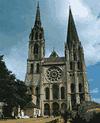- Chartres Cathedral
-
Cathedral of Notre-Dame at Chartres, one of the most influential examples of High Gothic architecture.The main part of this great cathedral was built between 1194 and 1220. It replaced a 12th-century church of which only the crypt, the base of the towers, and the western facade remain. Abandonment of the traditional tribune galleries and the use of a unique type of flying buttress allowed for a larger clerestory. Remarkable stained-glass windows and a Renaissance choir screen add to its beauty.
 The cathedral at Chartres, Fr.Everett C. JohnsonDeWys Inc.
The cathedral at Chartres, Fr.Everett C. JohnsonDeWys Inc.* * *
also called Notre-Dame d'Chartres, or the Cathedral of Notre-Dame,Gothic cathedral located in the town of Chartres, northwestern France. Generally ranked as one of the three chief examples of Gothic (Western architecture) French architecture (along with Amiens Cathedral and Reims Cathedral), it is noted not only for its architectural innovations but also for its numerous sculptures and its much-celebrated stained glass. The cathedral's association with the Virgin Mary (Mary) (the supposed veil of the Virgin is kept in the cathedral treasury) made it the destination of pilgrims (pilgrimage) in the Middle Ages.The oldest parts of the cathedral are its crypt and the west portal, or Royal Portal, which are remnants of a Romanesque (Romanesque art) church that was mostly destroyed by fire in 1194. The present cathedral was constructed on the foundations of the earlier church and consecrated in 1260. Built of limestone, it stands some 112 feet (34 metres) high and is 427 feet (130 metres) long. In many ways, the cathedral's design resembles those of its contemporaries, especially Laon Cathedral (Laon), but it displays innovations with its tall arcades (arcade), unusually narrow triforium, and huge clerestory—the massive weight of which required using flying buttresses (buttress) in an unprecedented manner.The cathedral contains an immense amount of sculpture, particularly figure sculpture, ranging from large column statues to miniatures. As the purpose of the sculptures was to preach and instruct, they mainly depict scenes and figures from the Old and New Testaments.Chartres Cathedral contains 176 stained-glass windows, the feature for which it may be best known. Like the sculpture, the stained glass was intended to be educational. The five windows of the choir hemicycle (a semicircular arrangement) relate in various ways to the Virgin Mary. The rose window in the north transept portrays figures from the Old Testament. The south transept, which is representative of the New Testament, has a rose window depicting the Apocalypse.Several alterations have been made to the cathedral. The northwest tower's distinctive spire, for example, was added in the early 1500s. Chartres emerged with relatively little damage from the political and religious upheavals of the 16th century and sustained less damage than most cathedrals during the French Revolution (France) (1787–99). After a fire damaged the roof in 1836, a series of restorations were carried out during the 19th century. In 1979 Chartres Cathedral was designated a UNESCO World Heritage site. During the late 20th century preservation efforts concentrated on protecting the cathedral's stained glass from air pollution damage.Additional ReadingJean Favier et al., The World of Chartres (1990; originally published in French, 1988), covers the history of the cathedral and includes more than 200 photographs. Whitney S. Stoddard, Sculptors of the West Portals of Chartres Cathedral (1987), examines the origins of the Chartres sculptures and names possible artists. Jan van der Meulen, Rüdiger Hoyer, and Deborah Cole, Chartres: Sources and Literary Interpretation: A Critical Bibliography (1989), presents sources on all construction at the site until modern times and includes works on ecclesiastical, historical, and iconographic interpretation.* * *
Universalium. 2010.
